[This is the first review in my “Three Winter Omakase” series. Winter Omakase Counter at Sushi Taro is the second. Winter Lunch Omakase at Kiriko will be the third.]
Last month I returned to Shunji Nakao’s eponymous Japanese restaurant on Pico near Bundy for another amazing omakase experience. I consider my first omakase there last April the catalyst for my then-newfound appreciation for extremely high quality Japanese cuisine. This time, I dined with fellow food enthusiast Chris Hei (who was much more timely with his posting of our meal). Since we had the same dishes and his pictures have already been on the web for nearly a month, I’ll endeavor to distinguish my review from his by basically being a lot more verbose. :-)
I arrived before Chris, right after 6 PM on a Thursday, and noticed the parking lot was already decently filled. It’s not a large lot to begin with, but it’s a good sign that the business is doing well. I walked in and was warmly greeted by hostess/waitress extraordinaire Yuko, as well as Shunji himself. I was seated at the right-most seat of the bar, and Chris arrived shortly after. Yuko took our drink order (pretty boring that night, just water), but not our food order. Instead, we simply trusted Shunji with the dishes he presented us for the next 2.5+ hours…
We started with a refreshing kurage (jellyfish) sunomono, which was not as strongly pickled as sunomono usually is.

I’m used to having cold, shredded jellyfish marinated in vinegar, sesame oil, and soy sauce, at dim sum places, and it was refreshing to have a jellyfish dish that didn’t try to knock my socks off with bold flavors.
Next came a seasonal specialty, shirako (milt) prepared two ways. The idea of eating milt may not seem pleasant, and Yuko’s tongue-in-cheek translation of the dish into “Male Sensitive Parts” on the specials blackboard probably doesn’t help. ;-) While the consistency is rich and creamy (insert joke here), the flavor is quite mild and subtle.
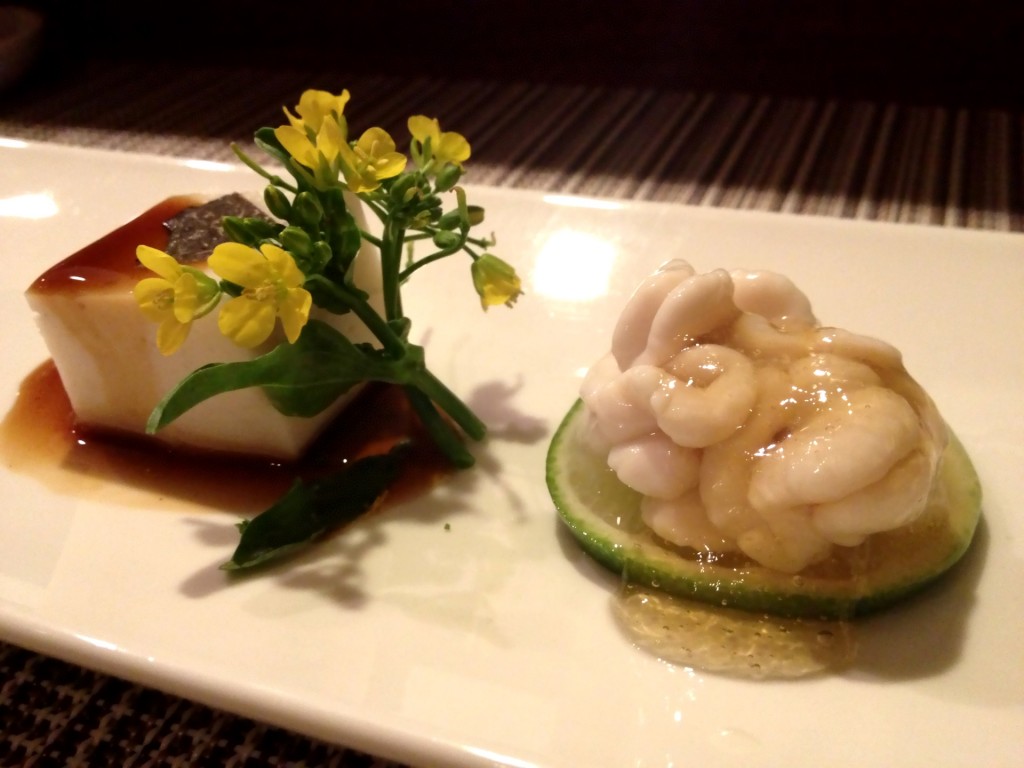
Of the two preparation, the star of the dish, and the star of the meal for me, was the shirako tofu. It’s a mystery to me how Shunji is able to distill an ingredient and then reassemble it into a gelatinous cube containing the pure essence of said ingredient, but I am glad for his ability. His signature agedashi tomato dish is probably the epitome of this technique, but the shirako tofu is its equal in its own unique way.
Next, a plate of small bites that Chris calls zensai (appetizer), which is definitely fitting, but I learned a new (to me) term on a recent trip to Sushi Taro in Washington, D.C. (reviewed here), hassun, which is used to describe the second course in a traditional kaiseki meal and consists of an assortment of small seasonal dishes.

I’ve had several of the individual items on previous visits, including the ever popular “balls” (maybe “truffles” would be a better term), one of ankimo (monkfish liver) mousse topped with caviar and one of purple potatoes and blue cheese topped with dried persimmon. The other items on the plate were a diminutive gomae spinach salad with pine nuts, a skewer of gingko nuts, a lone quail egg, prosciutto-wrapped okara (tofu paste) with crab , yam-stuffed shrimp, and two preparation of herring roe: kazunoko (a piece of a lobe of roe) and komochi kombu (salted roe on a piece of kelp).
Next, we were served a cold soup, a course which I was also served at my first omakase there. That time it was winter melon with chunks of mountain yam and shaved foie gras.

On this night, the main ingredient was potato, with napa cabbage, and a lone raw oyster. Of the two, I definitely preferred the winter melon, but this was still cool and refreshing, with a briny bite from the oyster.
Next was one of my wife’s favorite ingredients, fresh bamboo, available around here only for the first few months of the year.

Shunji kept the preparation simple, with the bamboo lightly roasted, floating in mozuku seaweed, and topped with uni. The mild, woody flavor of the bamboo paired well with the uni’s sweet nuttiness. Umami abound with this dish!
Next, seared hotate with a light miso dressing and grated daikon.
Great raw scallops stand on their own, and Shunji was happy to let these not be overshadowed by strong saucing or accompaniments.
Next, a trio of sashimi, consisting of hon maguro akami (lean bluefin tuna), hirame (halibut), and suzuki (sea bass).

As expected, the fish were all very fresh. The mildness of the hirame helped cleanse my palate between the deep taste of the lean akami and the richness of the somewhat fattier suzuki.
Next, one of L.A. Times’ food critic Jonathan Gold’s favorite, and one of mine, squid ink “pasta” with quail egg yolk.
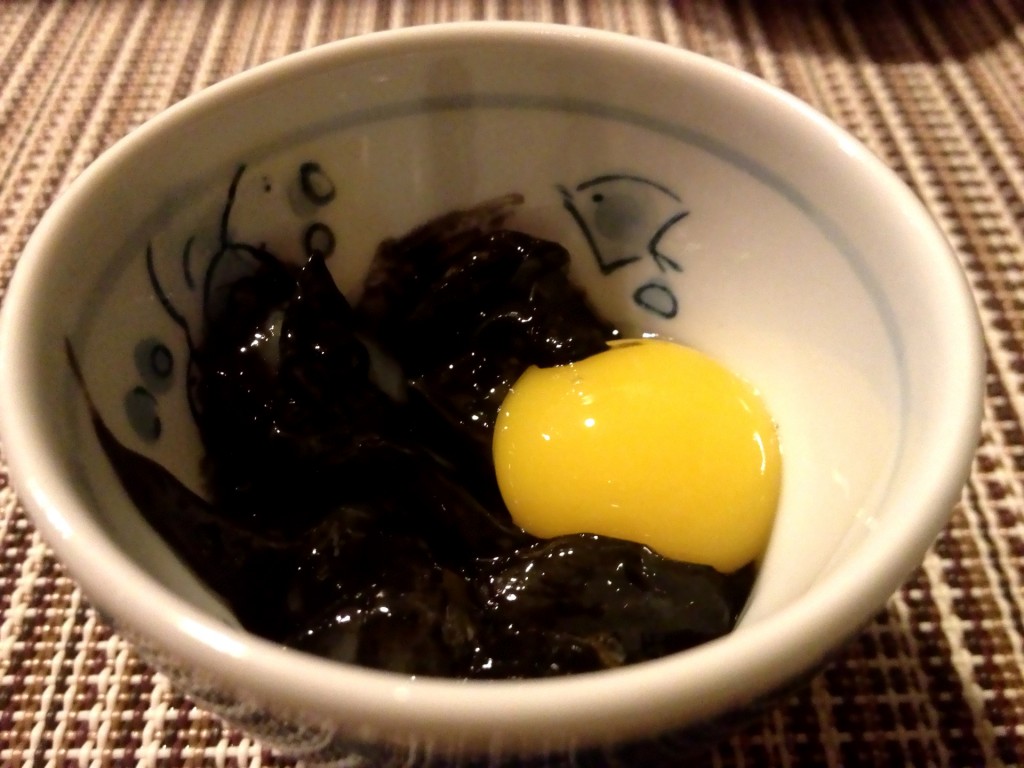
For this dish, Shunji slices raw ika (squid) into thin strips to serve as the pasta. He then mixes them with the squid ink, probably some dashi, and then serves them with a quail egg yolk. In the past, he’s embellished the dish with bits of uni or a sprinkling of gold flake, but it’s perfect just like this. I ate some of the “pasta” on its own and then broke and mixed the yolk into it, for two slightly different flavor and textural experiences.
Next, a signature dish that Shunji’s brought with him from past restaurant ventures, agedashi tomato tofu. Agedashi tofu is a traditional Japanese dish of lightly fried bean curd served in a bowl of tentsuyu broth (dashi, mirin, shoyu).

Shunji serves his tomato tofu in a delicate dashi broth. As far as what makes up the tofu, Shunji says it is just pure tomato. However, this is not just a block of tomato paste. I don’t know how he blends it or gets it to stay together through a frying, but it is somehow both light and rich, not overpowering like one might imagine tomatoes concentrated into this form might be.
Next was a dish of shrimp-stuffed renkon (lotus root) tempura, served with matcha salt.
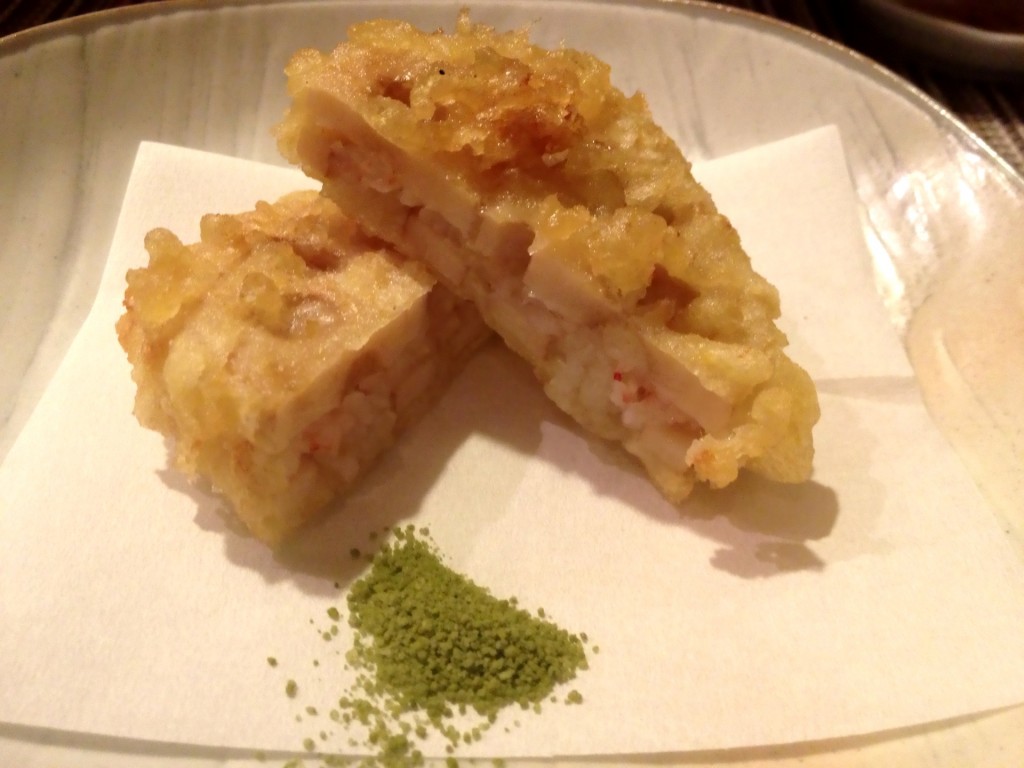
The lotus roots was nice and crisp, not gummy or crumbly like other starches that undergo the tempura treatment. The shrimp added a meaty sweetness, and gave the bites a little more heft. The green tea salt was a great accompaniment, adding flavor without making the tempura soggy like a dipping sauce would have.
Next was sawara (king mackerel) saikyo-yaki, with a yamamomo (mountain peach). Saikyo miso, from Kyoto, is a lighter (both in color and in salt content) miso that is used in this preparation to marinate whatever is to be grilled before it goes on the fire. I had had an excellent foie gras saikyo-yaki at Shunji last year before the ban went into effect, and I was looking forward to trying another saikyo-yaki dish.

The sawara surprised me with its lightness. I was expecting the unctuousness of a saba (Atlantic mackerel), but while it was still relatively fatty, it had a flakiness that reminded me a little of Chilean sea bass. The yamamomo has a great sweet/tart combination, and reminded me of pickled ume (Japanese plums).
After the sawara saikyo-yaki, and about an hour and a half into the meal, Chris and I indicated to Shunji that we were ready for the sushi course. Shunji started us with a trio of shiromi dane (white fish) nigiri.

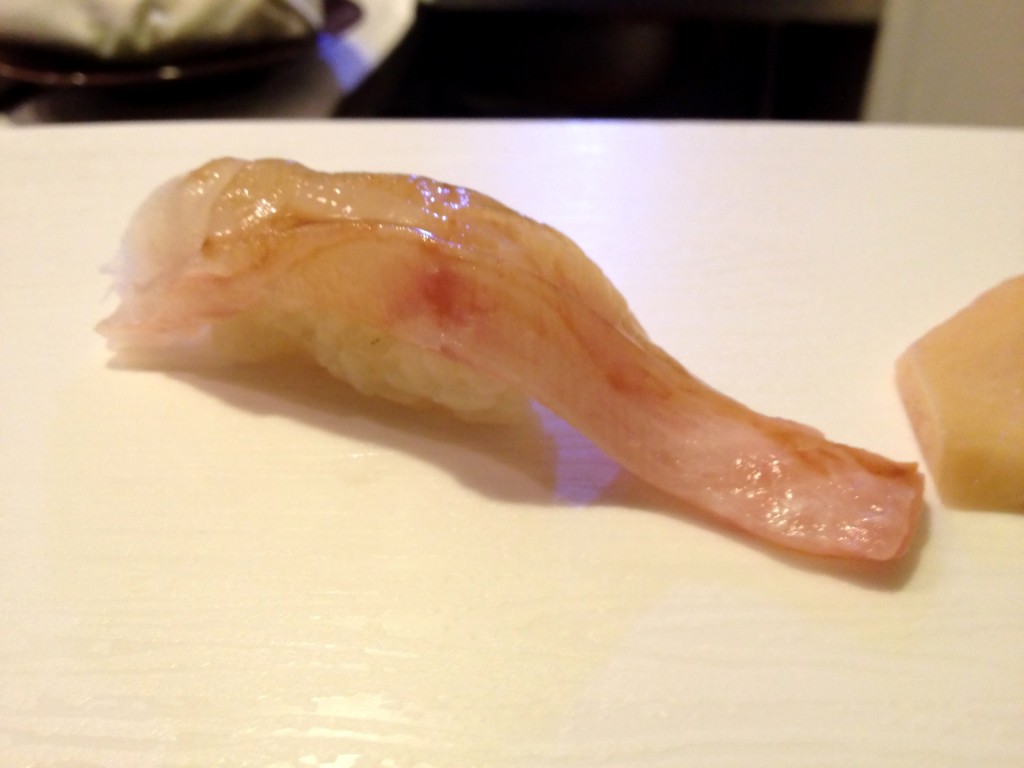
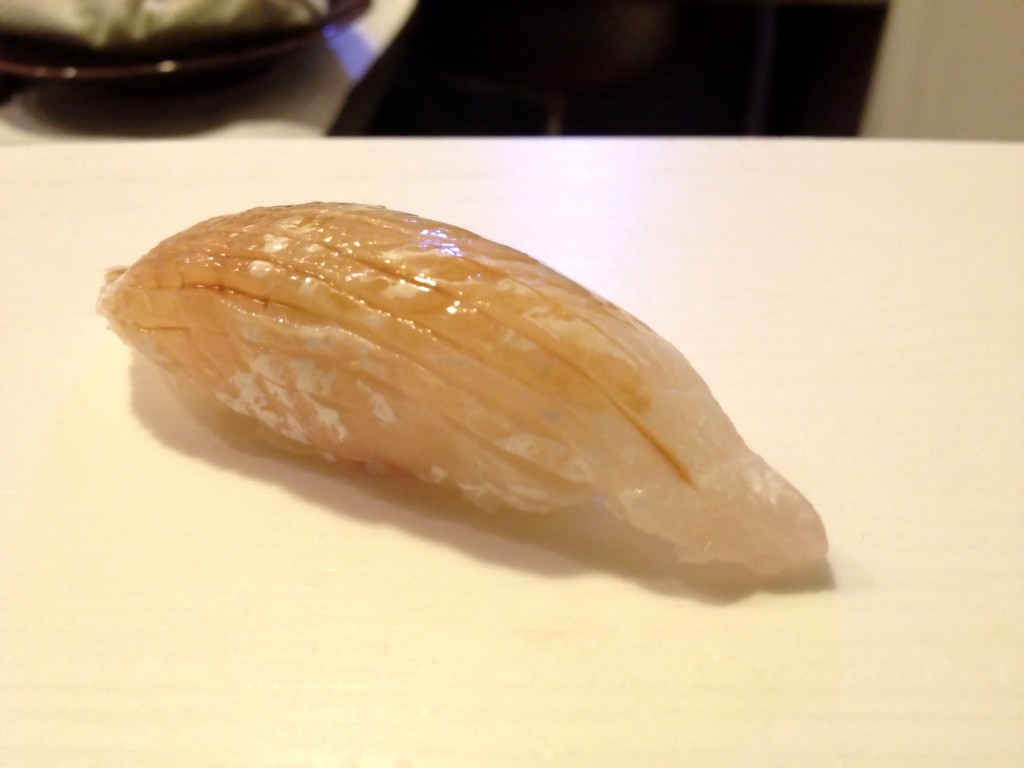
The aka isaki (red grouper) was simply dressed with a sprinkling of sea salt, while the renko dai (red sea bream) and meichi dai (porgy) had shoyu brushed on by Shunji. None of them needed additional soy sauce, and each were delicious in their own mild, subtle way.
The next piece of nigiri was inada (baby wild yellowtail). Wild yellowtail sushi is known by different names based on the maturity of the fish. Buri is from the mature fish, warasa is slightly less mature, and I guess that, while inada is referred to as “baby”, smaller and younger wild yellowtail is known as wakashi.

Unlike the hamachi (farmed yellowtail) found in most sushi restaurants, the various kinds of wild yellowtail do not just melt in one’s mouth. The inada had a great chew to it, with a rich, slightly fatty taste.
Shira ebi (raw baby white shrimp) nigiri, which I had not had before, was the next piece.
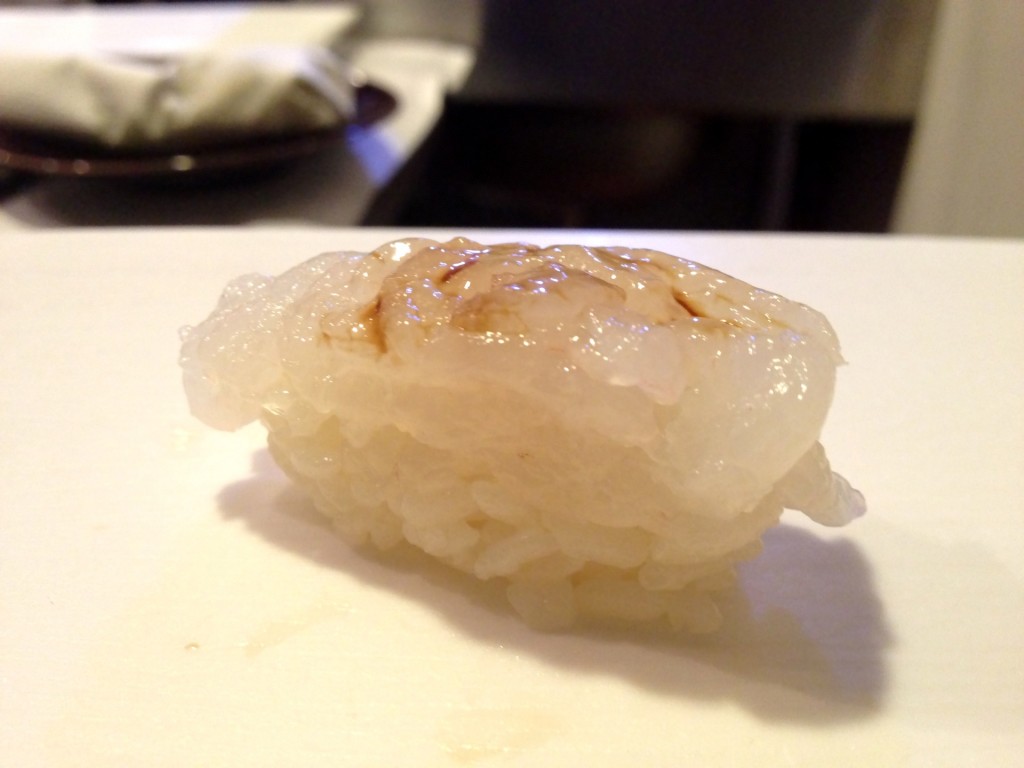
The tane or neta (the main ingredient in a piece of nigiri that sits on top of the shari, or sushi rice) consisted of many little white shrimp, with just a light drizzle of shoyu on top. The shrimps were not as plump or sweet as their cousin amaebi (sweet shrimp), but were still quite delicious.
Following the newness of the shira ebi was an old favorite, kanpachi (amberjack).
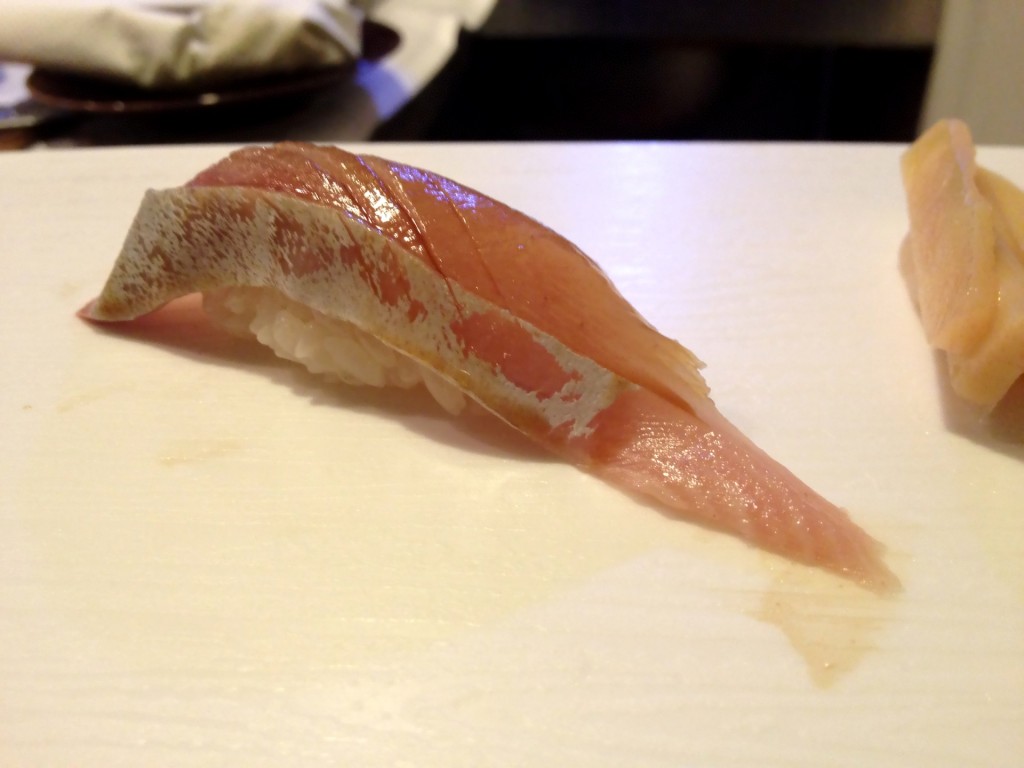
I remember on my first few visits to Shunji last year, during his soft-open, he had not stocked the wide variety of fish that he has now, and he had no variety of yellowtail at all for a while (neither farmed hamachi or the wild inada, warasa, buri). He would offer kanpachi instead, as it has a somewhat similar taste and texture to the ubiquitous farmed yelllowtail, but with a stronger hint of its hikarimono (silver-/shiny-skinned fish) nature, almost like a cross between hamachi and aji (horse mackerel; often referred to as Spanish mackerel).
Next was minced toro (fatty tuna belly), presumably from the same hon maguro that gave us the akami sashimi earlier.
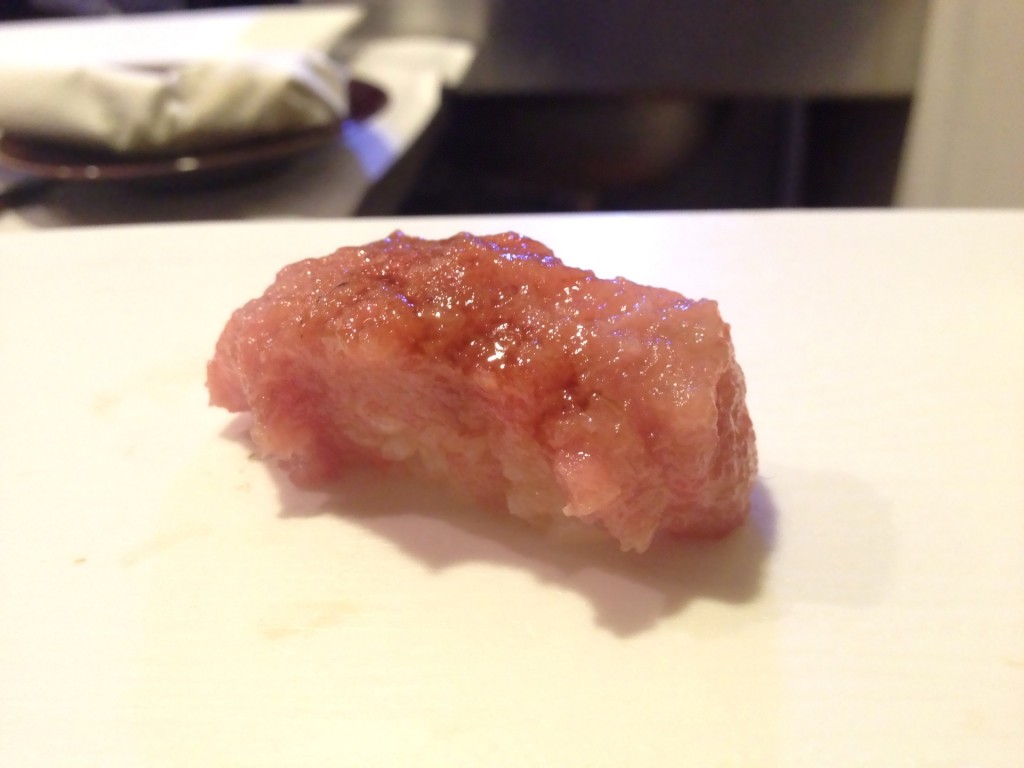
I never quite understood why one would mince toro, since whole slices of toro generally fall apart in ones mouth anyway, so I usually don’t order negitoro maki (minced toro and scallions roll) because I don’t need any help chewing my food. :-) But I can’t argue that this nearly unadulterated version, just toro, shari, and a few drops of shoyu, tasted sublime.
Our penultimate piece of nigiri was of aori ika (bigfin reef squid) on kelp, sprinkled with smoked salt and yuzu zest
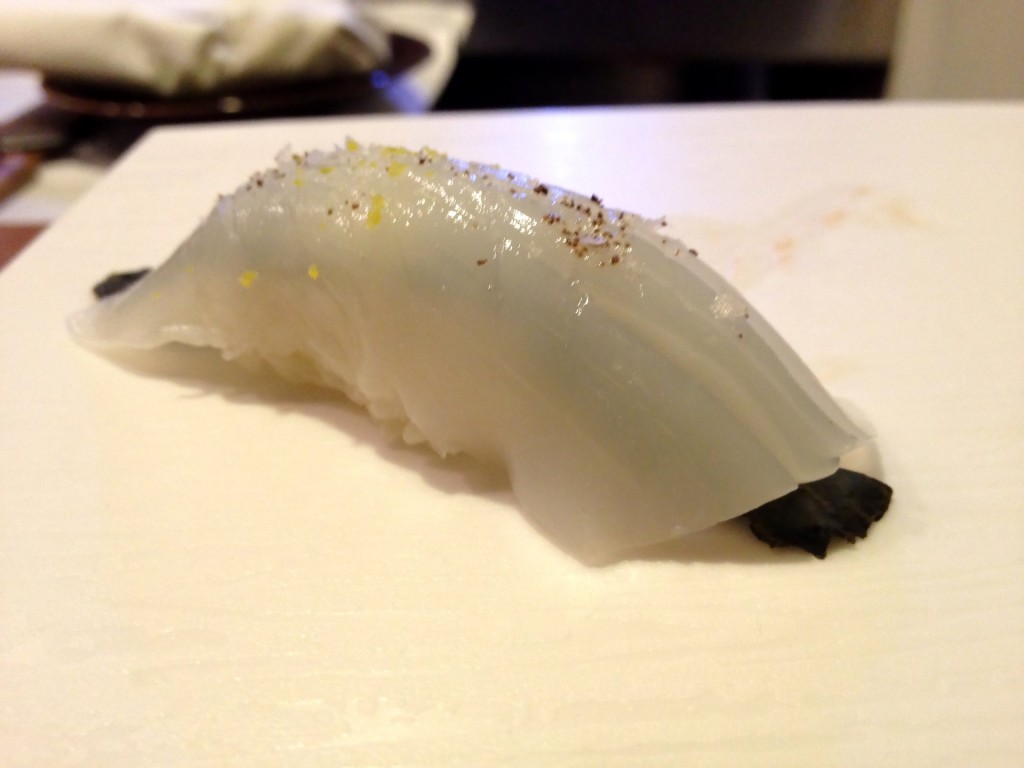
I’ve had aori ika twice before, once when it was tender to the point of being creamy, and once when it was as chewy as squid sushi from the supermarket (not that there’s anything wrong with that). Luckily, Shunji’s aori ika fell into the former camp, and it was indeed sweet and tender, with the kelp adding a bit of salinity to highlight the natural flavor of the squid.
Our last piece of nigiri was live Japanese hotate (scallop), freshly shucked from the shell.
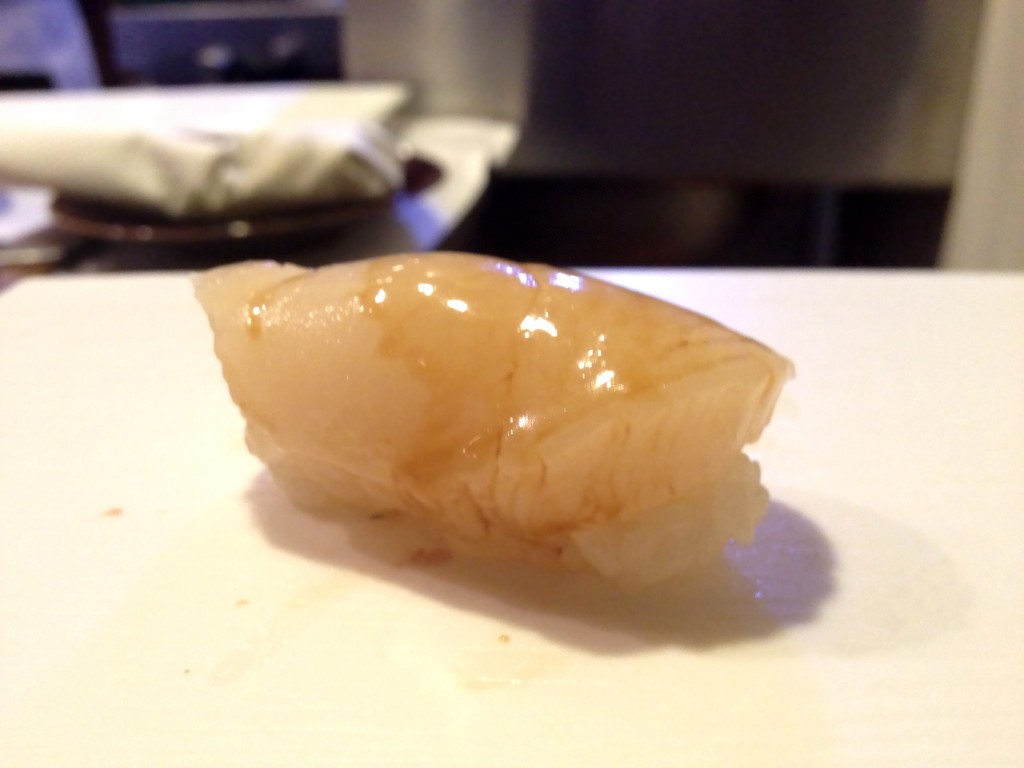
I absolutely love shellfish, especially mollusks, and particularly bivalves (and gastropods, but, since we had none that night, I digress). For sushi, fresh, live scallops are probably as good as it gets. The scallop that Shunji shucked and served to us was sweet yet briny, tender yet chewy (in a good way), making it one of the best hotate sushi I’ve had.
What was a particular treat was the maki that Shunji made with the parts of the scallop that one usually isn’t served, the slightly rubbery yet crisp mantle that surrounds the main adductor muscle that most people know as the “scallop”.

Not only was this a treat because of the novelty of it, but because it was just plain delicious. The addition of a little cucumber accentuated the natural “crunchiness” of the mantle, leading to some of the most satisfying bites of maki I’ve had.
A sushi-ya’s tamagoyaki is supposed to show the skill of the itamae, at least according to Jiro Dreams of Sushi. I am sure it is true, but I actually don’t go out of my way to try it. However, before being enchanted by the hotate, we were told by Yuko that Shunji had finally started making tamagoyaki and that we should try it, so being the good customers that we were, we ordered it as our last pieces from the bar.

It was quite good, and the intricate layering that I could see within what may first appear to be a homogeneous block of egg spoke to the skill it took to make it. I think though, as much as I hate to say it, I prefer the tamagoyaki from Kiriko; it is a different style, with a texture that’s similar to a liqueur-soaked ladyfinger from a tiramisu, and more strongly infused with essence of shrimp.
We were just ready to signal to Shunji that we were getting full when a bowl of lobster misoshiru was brought out to us.

The soup was well executed but definitely enhanced by the addition of the lobster head, which, while it did not contribute a great deal of meat, did bring its rich tomalley and roe to the party, making it a heartier soup than misoshiru usually is.
After we indicated that we were done for the evening, Shunji surprises us with one last bite of something we had never had before, noresore (baby sea eel) sunomono.

Flavorwise, the noresore was pretty mild, and so it was good that it was infused with vinegar and ginger. Texturally, just from looks I may have expected it be a bit chewy like ika or snappy like kurage, but it was actually incredibly tender, almost ephemeral.
While this last course didn’t knock my socks off, I don’t think that was Shunji’s intention. Instead, it brought the meal and the entire nearly-three hour experience full circle, ending nearly as it started, with cool, translucent strands that cleansed the palate. Once again, Shunji came through with an exquisite experience that was beyond reproach.
—–
Shunji Japanese Cuisine
12244 W Pico Blvd
Los Angeles, CA 90064
(310) 826-4737
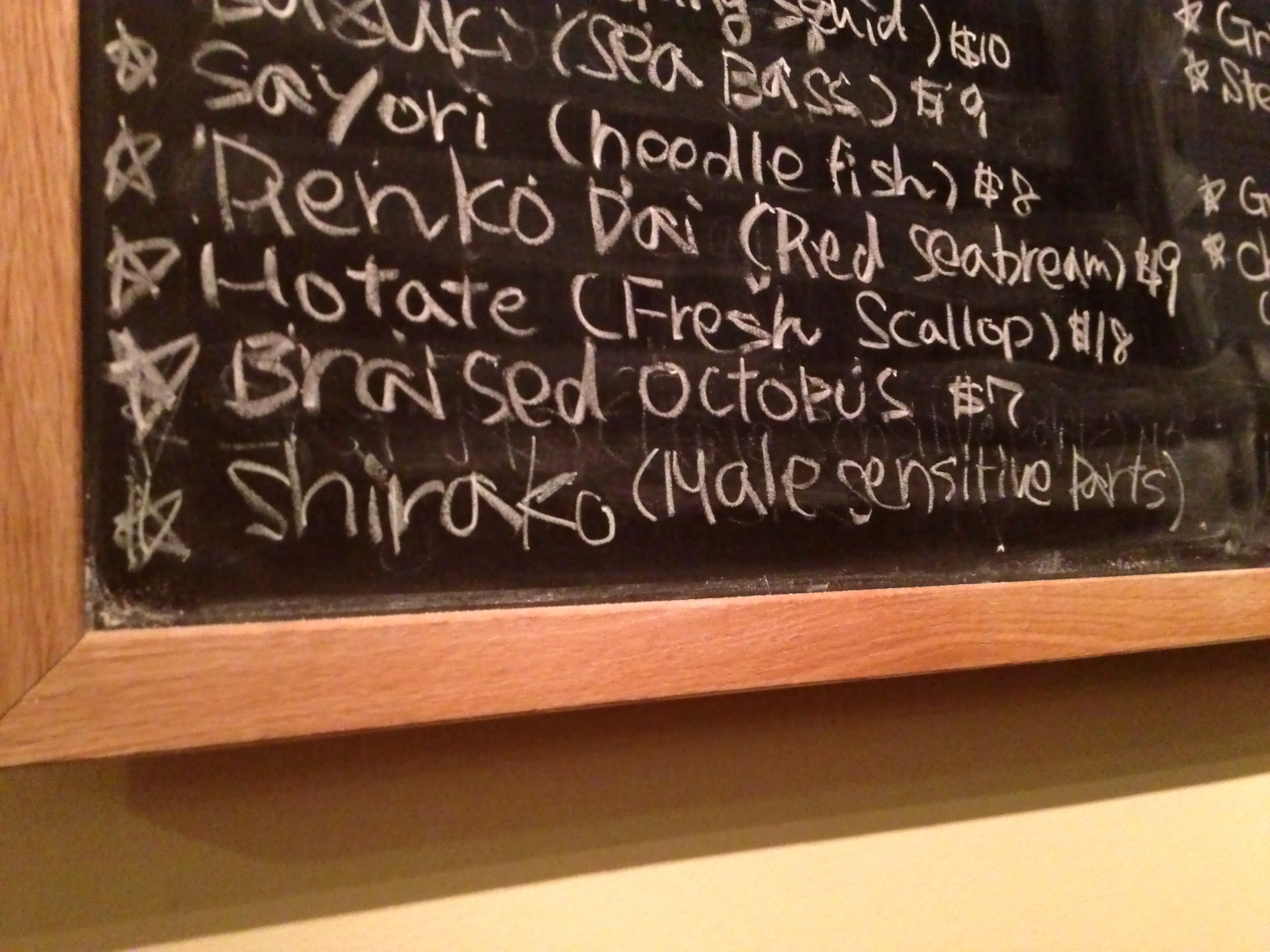

Leave a Reply